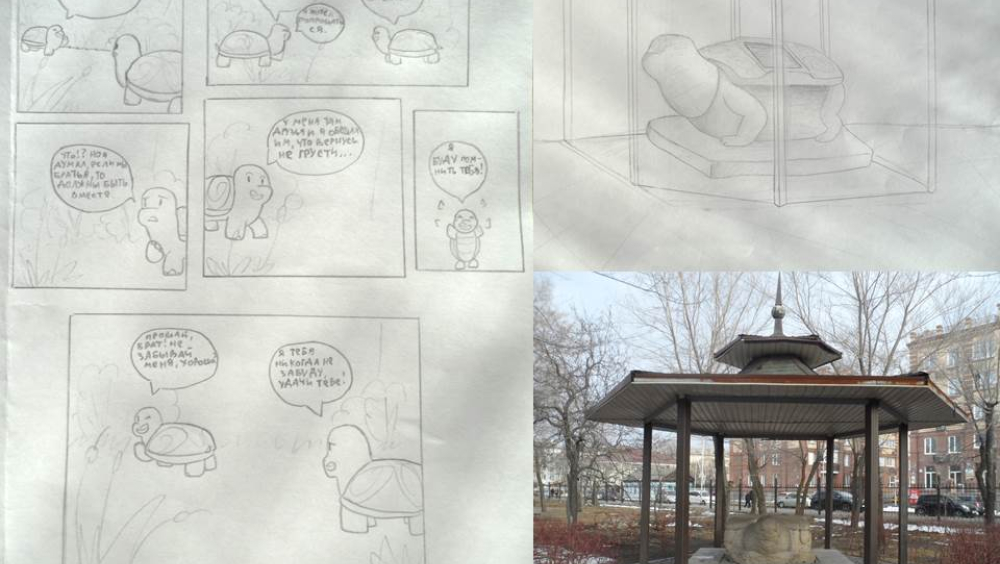The stone tortoise
Vue d'ensemble
Каменная черепаха.
Удивительный город, расположенный на далекой окраине нашей страны более чем в 10 тысячах километрах от центра Европы - это Уссурийск, Приморский край, Россия. Город, основанный русскими и украинскими переселенцами, военными и казаками, имеющий европейское происхождение, своим неофициальным символом выбрал символ поклонения азиатских народов - каменную черепаху Биси.
Гранитный памятник высотой 65 сантиметров, стоящий на постаменте высотой около 15 сантиметров, является объектом культурного наследия Приморского края и единственным и уникальным монументом таких размеров, связывающий Уссурийск со средневековыми цивилизациями, существовавшими на этих землях.
Специалистами считается, что каменная черепаха была создана чжурчжэнями для основателя государства Восточное Ся - Пусяня Ваньну и была установлена в родовом погребальном комплексе. Это произошло в первой половине 13-го века, то есть около 800 лет назад. Через черепаху дух умершего, похороненного в соседнем кургане, покидал землю.
В те годы губернский город государства Восточного Ся - Суйпинь, находился на месте нынешнего Уссурийска. По тем временам, если судить по меркам Европы, это был огромный город. По данным исследователя Александра Мезенцева, его площадь составляла 15 квадратных километров. По своим размерам он более чем в 3 раза превосходил Париж и более чем в 7 раз – Лондон. Площадь Московского кремля на тот момент составляла около 3-х гектаров, тогда как площадь внутреннего города Суйпиня простиралась на территории в 116 га. По меркам Европы это был мегаполис. И это притом, что это была даже не столица, а губернский город.
Но его ждала та же печальная участь, что и города Древней Руси и ряд городов Восточной и Центральной Европы. Он был разрушен монголами в 1233 году. Спустя несколько лет монголы уничтожили Владимиро-Суздальскую, Киевскую Русь и наводили ужас на жителей Восточной и Центральной Европы.
Суйпинь был уничтожен, но черепаха осталась.
Ее обнаружили почти спустя 630 лет русские переселенцы во второй половине 19-го века. Черепах было две, вторая также предназначалась знатному вельможе императорского чжурчжэньского рода и была изготовлена на 100 лет раньше - в 12-м веке. Но ее еще в конце 19-го века увезли из Уссурийска, который в то время назывался село Никольское, в музей Хабаровска. Там она и стоит свыше 120 лет. А вторая черепаха - ее называют уссурийской, осталась в нашем городе и вместе с древним Краснояровским городищем является ее главной достопримечательностью и неофициальным символом города.
Черепаха стоит в городском парке почти в том же месте, где когда-то ее нашли русские переселенцы. Несколько лет назад над ней сделали беседку в виде пагоды.
Ею восторгаются и местные жители, и туристы, особенно из стран Азии.
[ENGLISH VERSION] The stone tortoise
Ussuriysk, Primorsky Krai, Russia, is a unique city located on the distant frontier of our country country, more than 10 thousand kilometers from the center of Europe. The city with a European heritage, which was founded by Russian and Ukrainian migrants, military personnel and Cossacks, later chose a Bixi, stone tortoise-like figure worshipped by Asian nations, as its unofficial symbol.
The 65-centimeter granite monument, standing on a pedestal about 15 centimeters high, is an object of cultural heritage of the Primorsky Krai and the only surviving unique monument of such a size connecting the modern city of Ussuriysk with the medieval civilizations that existed on these lands.
Experts believe that the stone tortoise was created by the Jurchen for Puxian Wannu, the founder of the kingdom of Eastern Xia, and was erected in the family burial complex. This took place in the first half of the 13th century, that is, about 800 years ago. The spirit of the deceased man, who was buried in a nearby mound, was supposed to leave the earth through the tortoise figure.
In those years, Sùpín, the center of a circuit in the kingdom of Eastern Xia, was located on the site of the present-day Ussuriysk. It was a huge city by the European standards of the same time. According to researcher Alexander Mezentsev, its area was 15 square kilometers. It was more than 3 times as large as Paris and more than 7 times as large as London. The area of the Moscow Kremlin at that time was about 3 hectares, while the area of the inner city of Sùpín stretched over an area of 116 hectares. By the standards of Europe, it was a metropolis. That being said, it was not even the capital of the kingdom, just a major provincial city.
But it suffered the same destiny as the cities of Ancient Rus’ and a number of cities of Eastern and Central Europe. It was destroyed by the Mongols in 1233. A few years later, the Mongols destroyed Vladimir-Suzdal, Kievan Rus and terrified the inhabitants of Eastern and Central Europe.
Sùpín was destroyed but the stone tortoise stayed here.
It was discovered almost 630 years later by Russian settlers in the second half of the 19th century. There were two tortoises, the second was also intended for a nobleman belonging to the royal Jurchen family and was made 100 years earlier - in the 12th century. But at the end of the 19th century it was taken from Ussuriysk, which at that time was known as the village of Nikolskoye, to the Khabarovsk Museum. It has been being exhibited there for over 120 years. And the other tortoise, which is called the Ussuriysk tortoise now, remained in our city and, together with the Krasny Yar ancient hill fort site, it is its main attraction and unofficial symbol of the city.
The tortoise is located in a city park almost in the same place where Russian settlers once discovered it. Several years ago, a pagoda-shaped shelter shed was built to cover it.
It is admired by both the city residents and tourists, especially those coming from Asian countries.
